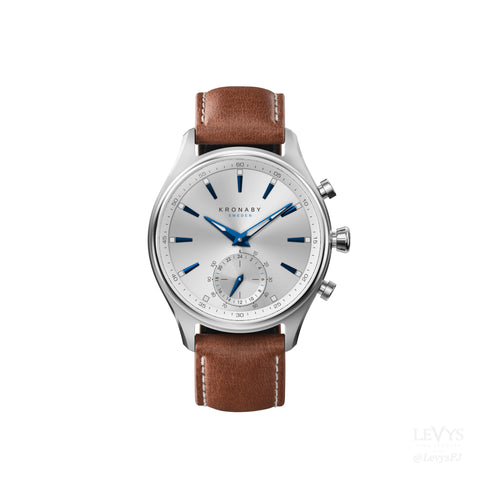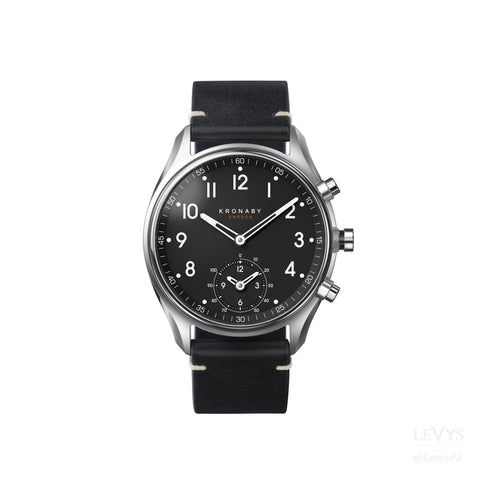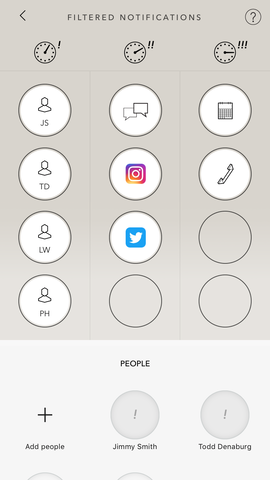Article by: Jimmy Smith
 Having been a part of the jewelry trade for nearly 21 years I’m probably a little more “old school’ than I care to admit. So when we were approached by a longtime acquaintance proposing that Levy’s carry smart watches I cringed and escaped the conversation with cat like reflexes!
Having been a part of the jewelry trade for nearly 21 years I’m probably a little more “old school’ than I care to admit. So when we were approached by a longtime acquaintance proposing that Levy’s carry smart watches I cringed and escaped the conversation with cat like reflexes!
You see, my father put my first watch on my wrist when I was only eight years old and still today it’s something I don’t leave home without. I love the craftsmanship of mechanical timepieces, vintage or modern. Classic dials, sweeping motion of the hands, intricate workings of the movements down to the tiniest, yet important parts. I have always had a soft spot for all things horological as do many in this industry. To think of wearing a watch that “isn’t a watch”, doesn’t function like one and comes from the same company that may manufacture my television just seems sacrilegious.
So with all of these predisposed notions, in comes Kronaby Sweden, a designer and manufacturer of a proprietary movement that is better described as a “hybrid timepiece” rather than “smart watch”. Upon picking it up I was impressed the weighty feel of a solid, stainless steel case with a refined, almost retro look to the dial. Needless to say my opinion began to sway. The look of the watch is on par with many fine timepieces as well as popular styles. A representative for another watch brand actually mistook the personal one I’m wearing now (spoiler alert) for a beautiful Panerai!
 All production and assembly is done in house for Kronaby, from movements, to cases and dials. This ensures the highest standards are met so each will be an elegant, timeless and durable watch meant to stand the test of time. Featuring machine turned dials, sapphire crystals, stainless steel bodies and bracelets, some with rich color finishes and white stitched genuine leather straps, they have a very desirable look.
All production and assembly is done in house for Kronaby, from movements, to cases and dials. This ensures the highest standards are met so each will be an elegant, timeless and durable watch meant to stand the test of time. Featuring machine turned dials, sapphire crystals, stainless steel bodies and bracelets, some with rich color finishes and white stitched genuine leather straps, they have a very desirable look.
But, the movement is the real star of the show. Each watch features traditional analog timekeeping as well as multiple connectivity functions for modern convenience. I’ve been wearing the Apex model, which is a 43 millimeter round case with a handsome black leather strap. Initially it resembles a typical chronograph with a main crown and two push actuators. The function of these can be set with the Kronaby app which is compatible with Apple IOS as well as Android devices.
 Upon downloading the app you are prompted to enable Bluetooth on your device and depress the crown on the timepiece. This will “pair” them and begin your experience. Once paired, you will follow simple step by step calibrations and your time will automatically set for you. The functions are in the app listed under “watch face” and pushers”. When you select “watch face” you will be given choices for Date and Daily 100. It’s as easy as touching the function you would like and dragging it in place to begin use. After setting your options, depress the crown and the hands jump into action to indicate date using the markers on the dial or displaying whichever function you choose.
Upon downloading the app you are prompted to enable Bluetooth on your device and depress the crown on the timepiece. This will “pair” them and begin your experience. Once paired, you will follow simple step by step calibrations and your time will automatically set for you. The functions are in the app listed under “watch face” and pushers”. When you select “watch face” you will be given choices for Date and Daily 100. It’s as easy as touching the function you would like and dragging it in place to begin use. After setting your options, depress the crown and the hands jump into action to indicate date using the markers on the dial or displaying whichever function you choose.
The Apex has a sub-dial at the bottom which also has functions listed under “watch face”. You are given the same choices in addition to a second time zone setting, useful for frequent travelers. If you select the Daily 100 (I use this one every day) the sub-dial will track steps during the day and you can check total progress in the app.
 The “pushers” have several interchangeable features as well. Using the same “click and drag” system within the app you can set your Kronaby to control music and volume on your device. There is also a find phone function, “remember this spot” which can drop a “pin” to save a location in maps, and a camera remote feature. You can also pair with another device and using the “walk me home” option someone can be tracked to ensure safe travel between locations. This is an unbelievably useful tool for someone who has children, like myself. Lastly, the IFTTT gives your Kronaby, when paired with a hub device such as Alexa, the ability to manipulate household operations like turning lights and alarms off or on, opening garage doors, locking doors and other functions that gadget fans will enjoy.
The “pushers” have several interchangeable features as well. Using the same “click and drag” system within the app you can set your Kronaby to control music and volume on your device. There is also a find phone function, “remember this spot” which can drop a “pin” to save a location in maps, and a camera remote feature. You can also pair with another device and using the “walk me home” option someone can be tracked to ensure safe travel between locations. This is an unbelievably useful tool for someone who has children, like myself. Lastly, the IFTTT gives your Kronaby, when paired with a hub device such as Alexa, the ability to manipulate household operations like turning lights and alarms off or on, opening garage doors, locking doors and other functions that gadget fans will enjoy.
There is also a feature for “filtered notifications” within the app. This provides your timepiece the ability to notify you of texts and phone calls from everyone or select persons you choose which you can also be declined from your watch. Chosen people can also be prioritized to give you one of three vibration alerts from the watch.
 The app itself gives you activity trackers which tell you total steps taken in a day, provides information for “pins” placed or tracking. They even have a locator built in that will find your watch if misplaced or stolen! The app is kept up to date by Kronaby which updates functions on the watch simultaneously. This prevents the need to buy another one in the future since it’s always providing current features. There is no need to charge a Kronaby like other smart watches since it uses a lithium 2032 battery which can be changed at most fine jewelers. Kronaby even warranties the movement portion for two years, whereas other smart watches give you at most one year of service.
The app itself gives you activity trackers which tell you total steps taken in a day, provides information for “pins” placed or tracking. They even have a locator built in that will find your watch if misplaced or stolen! The app is kept up to date by Kronaby which updates functions on the watch simultaneously. This prevents the need to buy another one in the future since it’s always providing current features. There is no need to charge a Kronaby like other smart watches since it uses a lithium 2032 battery which can be changed at most fine jewelers. Kronaby even warranties the movement portion for two years, whereas other smart watches give you at most one year of service.
Coming in 38 to 43mm sizes, they are the same dimensions as other smart watches. With the classic look of a stunning timepiece combined with such convenient features and impressive construction, Kronaby has far exceeded my expectations. This could well be the perfect blend of a traditional and modern timepiece that anyone can appreciate.
Having been a part of the jewelry trade for nearly 21 years I’m probably a little more “old school’ than I care to admit. So when we were approached by a longtime acquaintance proposing that Levy’s carry smart watches I cringed and escaped the conversation with cat like reflexes!
